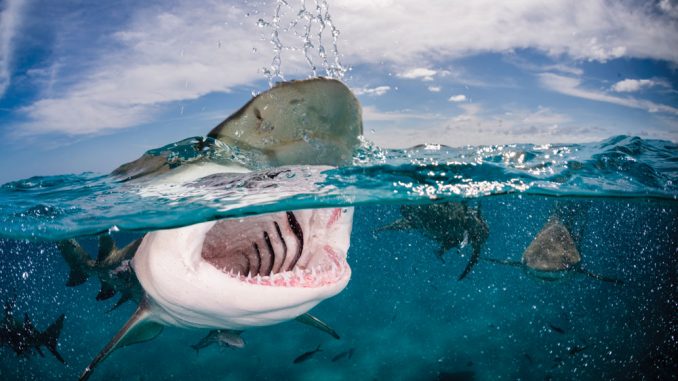
The sight of a shark fin circling in the ocean will frighten most people.
Yes, sharks do kill people, but not as many as you might assume. There are a few premises with regard to sharks and shark attacks that need clarification.
However, before we begin discussing these premises, here are some facts about sharks and their behaviors:
- Humans are way down on the sharks’ menu.
- With a few exceptions, sharks are timid creatures.
- Some parts of the coast are more predisposed to shark attacks than others.
- When to swim is as important as where to swim.
- Human blood is of no interest to sharks; there are many instances of divers with seriously bleeding wounds being totally ignored by nearby sharks.
- Excited, overzealous or erratic actions tend to attract sharks.
- My partner, Caroline, and I have often jumped into the middle of shark feeding frenzies and have never been attacked.
- Sharks are predators: Like all such animals, they zero in on the disabled, ill, old, incapacitated or the frail.
A Rare Threat
Sharks do kill people, but not many. On average over the last decade—and these events are calculated by various scientific bodies—there are six deaths from shark attacks recorded globally each year, and the fatality rate for those suffering unprovoked attacks is well below 10 percent.

As with every tale of conflict, there are two sides to every story. This photo was taken off the Zululand coast by Sijmon de Waal.
That figure is miniscule if you consider that, at any given time of the day or night there are more than a million people in the oceans of the world, swimming, paddling, tending nets, fishing, launching boats, diving, snorkeling and the rest. Only a tiny proportion of them ever gets to see a shark in its natural milieu. Those who do encounter these predators are rarely threatened.
Shark Behaviors
It is essential to accept that most sharks are timid creatures. I have dived with these predators for half a century, and almost always when I have encountered sharks underwater, they beat a hasty retreat as soon as I tried to get closer.
There are exceptions. Great white sharks are in their own unpredictable category and must always be regarded as a threat, even by the most experienced underwater enthusiasts. Yet, shark specialist and documentary filmmaker Mike Rutzen has had hundreds of encounters with great white sharks, and he has never been harmed. As he told me, one or two run-ins have been close, but he has always had enough time to reach his boat and clamber on board.
Had the critters that initially buzzed him been on a killing spree, they could have attacked in the blink of an eye: Great whites can reach speeds of 30 miles per hour when on the hunt and are rarely left wanting.
I have had two run-ins with great white sharks, both unintended. The first, diving off Fish Hoek in South Africa—an area notorious for shark deaths over many years. I was with a buddy in about 30 feet of water. Suddenly, a large great white, easily 13 or 14 feet long, charged past us from behind and disappeared into the murky depths ahead. It ignored us. The truth is, this big “man-eater” could easily have chomped either of us, had it wanted to do so.

An oceanic black-tip shark grabs the bait and runs. (Photo: Paolo Fossati; courtesy of Walter Bernardis)
The other time I encountered a great white close up was while wreck-diving in the Indian Ocean. After about 30 minutes below, I surfaced and returned to our tender. I was the last of five scuba divers to reach the boat. The dive, itself, was uneventful, because visibility was bad—perhaps 5 or 6 feet at best. In other words, looking down, I could barely see my fins.
Having reached the boat and handed up my scuba tank to the skipper, I had just started to mount the ladder that would have taken me on deck when an enormous great white surfaced right alongside me a little more than an arm’s length away. This was a monster, its upper body easily the size of one of those of old Volkswagen Beetles.
The shark stuck its head vertically out of the water; and now completely immobile, it eyed me carefully with its huge black eye for three or four seconds. Then, it sank silently back into the depths and was gone.
Clearly, that great brute must have been in the water with us during our dive, but not one of us spotted it. In any event, bad visibility in the water would only have allowed us to see a part of a leviathan that was easily 15 to 18 feet long.
Again, had it wished to do so, it could have gobbled up any one of us in a moment. But it did not.
It should be mentioned that most of the great white attacks at Fish Hoek over the years were on swimmers, almost all of whom had been warned beforehand that shark fins had been spotted earlier. Still, they persisted in going into the water. As a consequence, they paid the price.
Wrong Place, Wrong Time
Humans are very low on the feeding chain of the average shark. Attacks that do take place, such as several swimmers mauled by tiger sharks in Hawaii in recent years and by bull sharks in the Carolinas and off Australian and South African coastlines, were all considered to have been opportunistic. Simply put: The victims were in the wrong place at the wrong time.
[THE NUMBER OF SHARK ATTACKS] IS MINISCULE IF YOU CONSIDER THAT AT ANY GIVEN TIME OF THE DAY OR NIGHT THERE ARE MORE THAN A MILLION PEOPLE IN THE OCEANS OF THE WORLD …
That said, while we know that the great white shark is a killer, tiger and bull sharks are the two biggest culprits when it comes to actual attacks on humans—and for different reasons.
We will deal with bull sharks first. These sharks are regarded by divers (who encounter them most often) as the “terriers of the sea.” Bull sharks tend to hunt in packs—most times, in river estuaries or harbors where the water is dirty and visibility poor. They are the first to spot a likely victim … as they did with me a few years ago.

A female great white shark, Guadalupe Island, Mexico
I had suffered a serious bout of food poisoning and was laid low. On the third day, I decided to dive anyway. I had come from the States to dive with sharks and was eager to get into the water, even though I was still not well. The dive would cure all, I told myself.
The boat took us to some deep water adjacent to a reef. We jumped overboard, checked that all was okay with the team and submerged. Shortly afterward, a pack of bull sharks, perhaps six or seven, rose up toward us from the bottom, clearly curious. Moments later, they started to circle us, obviously interested in something.
It did not take the dive master very long to appreciate that the “something” attracting the sharks was me. He knew I’d been ill and had not yet fully recovered. Also, the sharks started coming at me at speed, veering off at the last moment. Then, some of these critters repeated the process a little later. It was all pretty unnerving.

A small female white shark gets very close to divers inside a cage.
Eventually, by means of hand signals, our dive master indicated I should surface and return to the boat. He waved toward the other divers in his group and pointed at the circling sharks, obviously suggesting that I was putting them all at risk.
I could not argue. With my forefinger and thumb, I indicated okay and headed toward the surface while keeping a wary eye open for sharks. Once alongside the boat, I didn’t wait to remove my gear or my tank but somehow found the strength to haul myself over the gunwale in a single, fluid move.
After the dive group returned to the boat, they told me that once I was out of the water, the sharks kept their distance, showing little interest in their presence. Lesson learned: Do not dive if you are not feeling 100 percent or have recently been ill.
Sharks in Tropical Waters
The other prominent “culprit” in many shark attacks in recent years has been the tiger shark, which, in divers’ lingo, is a devious bastard!
Partner Caroline and I often spent time in the water with Walter Bernardis’s African Watersports off South Africa’s coast. It is arguably one of the most famous shark diving operations in the world. Weather allowing, viewing of sharks from up close is a regular event: Walter chums with fish bait, and the sharks arrive. Tiger sharks are usually preceded by a couple of dozen black-tip oceanic sharks about 6 or 7 feet long.

A memorable view from the deck of a boat following great white sharks (Photo: Sijmon de Waal)
Walter is precise about risk. He has never had a client attacked, because he is both cautious and vocal about everybody staying together and not “wandering off on your own—because then, I’ve got to swim out and bring you back.”
WHAT IS IMPORTANT FOR ALL SWIMMERS AND DIVERS TO REMEMBER IS THAT MOST TIMES, SHARKS DO NOT SIMPLY GO INTO THE ATTACK MODE.
By the time we enter the water, the black-tips are everywhere—around us, under us, through our legs and, occasionally, entangled in our air hoses. But black-tips are not a threat, because they are only interested in fish bait; and anyway, the real reason we are in the water is because of tiger sharks, which are sometimes 18 or 20 feet long and usually arrive soon after the chumming begins.
Diving with tiger sharks needs a good level of vigilance; this is something those who frequent tropical waters need to understand.

This unnerving photo of a great white shark was shot by Robert Pakiela.
These creatures usually (but not always) move slowly and will come toward you—up to the point at which they make eye contact. Once these sharks are aware that you know they are there, they will veer off and try to approach from behind. Therein lies the threat. This is the reason that when diving, Caroline and I face each other in the water and cover each other’s backs. If a tiger shark approaches, we turn and face it, and the predator moves off.
What is notable here is that in several tiger shark attacks, these almost always came from behind. There are several instances of snorkelers in Hawaiian shallows having lost a leg (usually taken around the knee) to tigers. It would emerge afterward that the swimmers simply had no idea they were being stalked.

This diver’s safety was dependent upon his situational awareness— watching for aggressive actions among the large number of sharks in the area. (Photo: Getty Images)
The same was true for United Nations pilot Kevin Ellis, the son of mercenary helicopter gunship pilot Neall Ellis. Kevin was swimming in Mogadishu’s placid offshore lagoon (as he did every evening after work and for many months) when he was suddenly taken from behind by what was obviously an enormous tiger shark. Kevin’s right leg was severed at the knee—so cleanly that it looked as if a band saw had been used.
Two other factors need to be considered when swimming in the ocean. The first is that sunset is usually feeding time for the majority of sharks. Although most sharks will devour anything at any time, there is a greater risk of attack toward dusk. Statistics kept over decades indicate this is a distinct likelihood, which means it could cause problems if you are in the water as the sun sets.
The same applies to swimming in tropical waters at night. For a start, if there are sharks, you won’t be able to spot their fins prior to entering the water; nor will you see a tiger shark approaching from behind.
The other issue is dirty water. Here, I cannot be more specific. Never, ever dive in dirty river estuaries. Rivers flowing into the sea often carry with their flow a lot of detritus from yesterday’s events in the interior: an animal that drowned or the entrails of a deer shot by hunters and discreetly disposed of in the nearest stream.
Bull sharks, the culprit here, are aware of this, and they patrol those waters. Many a swimmer has been taken by these predators in those conditions.
The same applies to harbors. I have many friends who dive. Quite a few of them slot in a bit of extra work, such as cleaning hulls or clearing anchors that have fouled, and their stories about shark encounters are legendary. Also, it is no secret that big ports (such as Sydney) have a large shark presence; sometimes, these can be lethal.

This is what happens if you stick your hand out while diving with sharks. It was a nip, rather than a bite, and an oceanic black-tip was responsible.
Kenya’s biggest harbor, Mombasa, which is an island connected to the mainland by several bridges, also has shark problems. However, in some regards, these are peculiar.
Mombasa’s main shipping area is Kilindini, located on the south side of the island. It has seen many attacks. Over the years, numerous sailors (usually drunk) who have fallen into those waters while trying to board their ships have been taken by sharks. Then, there was an historical event that affected a good friend, Conway Plough, who lived and worked in Mombasa. I dived often with Conway, who knew the ropes about sharks. So, it was surprising that he was attacked.
Conway would often spend a few hours over weekends in Mombasa’s yacht basin cleaning the hulls of some of these craft. Then, one Saturday, he and another diving enthusiast, Dr. Jonathan Higgs, were cleaning a yacht when they were attacked by a pack of bull sharks. Higgs was killed. Conway survived, but a large chunk was taken out of his leg. It was notable that the approaches to the yacht basin were troubled that day, and visibility underwater was perhaps a few feet.
For all that, also in Mombasa, opposite the north side of the island, there is a large pontoon that has been well used by several generations of school children as a swimming platform, and there has never been a shark attack. Yet, the yacht basin is perhaps only a mile or two from the swimming pontoon.
There are many other issues related to sharks, but space precludes me from tackling them all, although I did cover most in my book, Shark Stories by Al Venter and Friends, which has been exceedingly well received by Amazon.
Sharks in Open Waters
I would be remiss if I did not mention attacks in open waters on divers who are sometimes separated from their boats. This was the subject of a particularly thought-provoking 2003 movie, Open Water. In this film, a pair of scuba divers surfaces, only to find that their dive boat has left them behind. Both victims are eventually taken by sharks … not a pretty picture.

Sharks continue to generate a lot of interest, even though the incidence of fatalities has been trending lower for decades. (Photo: Morne Hardenberg, founder, Shark Explorers)
But there are many other remarkable events where divers have survived sometimes impossible situations.
I was present at one of several incidents such as this along South Africa’s Indian Ocean coast, when a diver had disappeared in choppy seas after a dive. Although boats and helicopters searched for hours, the man appeared to have vanished—until he swam ashore about 100 miles down the coast the following morning, having been carried by currents all night long—in an ocean swarming with sharks.

The moment of truth for an underwater cameraman as a shark hits the bait (Photo: Stuart Philpott)
Something similar happened again a year or two later. That time, it was an 80-mile swim. In both cases, those involved never wavered. This underscores the need to always make a serious effort to reach the shore, no matter the odds.
What is important for all swimmers and divers to remember is that most times, sharks do not simply go into the attack mode. The majority will first “mouth” the potential victim by “tasting” whether he or she is edible. That can involve a bump, sometimes two or three bumps, from the shark’s snout. Most times, after mouthing wetsuit neoprene (hardly edible), the sharks will move on. But, when exposed swimmers’ limbs are mouthed, an attack might well result.

Shark conservationist Sijmon de Waal’s photo of a diver with a juvenile whale shark
The bottom line here is that if you are bumped while swimming or diving, get back to shore or onto your dive boat as quickly as possible.
Also, the reality of shark attacks is vastly overblown. With the Chinese removing almost 100 million sharks from the oceans every year with their armadas of long line boats (they remove only the fins to make shark fin soup), sharks today are far more threatened than a threat.
Shark Attack Facts
In 2016, the International Shark Attack File investigated 154 worldwide alleged interactions between sharks and humans. About 55 percent of these attacks were unprovoked, meaning that a live human was attacked in the shark’s natural habitat and there was no human provocation of the shark.
This is what was found:
- 84 were confirmed cases of unprovoked shark attacks
- 46 attacks took place in continental North American waters
- 35 of these 46 attacks occurred in Florida
- 10 of the 84 attacks took place in Hawaii
- There were no fatalities in North American waters
- Australia had 15 unprovoked shark attacks that resulted in two deaths
- The remaining attacks occurred in nine other countries
- Of the 84 attacks, four were fatal
Editor’s note: A version of this article first appeared in the March, 2018 print issue of American Survival Guide.





Be the first to comment